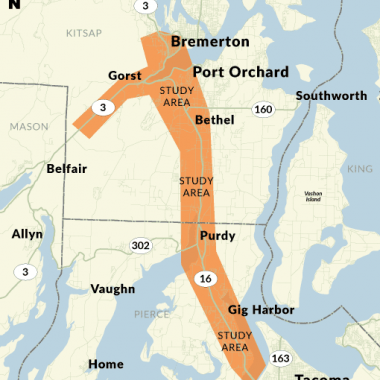The study report recommended near-, mid- and long-term strategies. Highlights of the recommendations include:
- Operational, channelization and signal improvements at key local and state locations.
- Capacity improvements at key local and state facilities by widening, roundabout, or signal installations.
- Improving pedestrian and bicycle facilities by the extension of the Cushman Trail, new facilities between Bremerton and Port Orchard and additions or enhancements to bike lanes along the corridor.
- SR 3 and SR 16 capacity improvements by peak-use shoulder lanes and widening.
- SR 304/Naval Base Kitsap-Bremerton area improvements at Farragut Avenue and Charleston Beach Road.
- SR 3/SR 16 interchange access control, intersection improvements and grade separation.
- Tremont Street and Sedgwick Road interchange capacity improvements at key intersections.
- SR 302 and Borgen Boulevard Interchange capacity, operational and queue storage improvements.
- Olympic Drive, Wollochet Drive, and Hunt Street crossing operational and capacity improvements.
Corridor-wide recommendations include:
- Strategies for maximizing traveler choices.
- Increased coordination of incident response.
- Plans for addressing resiliency and climate change.
- Additional park and ride capacity and coordination between agencies.
The study began in November 2016 and was completed in January 2019.
November 2016 - December 2016
Define project vision and goals.
January 2017 - April 2017
Understand existing conditions and corridor needs, public opinion survey.
May 2017 - September 2017
Develop and model strategies to improve travel.
October 2017 - December 2017
Gather public input on strategies, evaluate strategies.
January 2018 - May 2018
Develop final recommendations and share final recommendations with members of the public.
June 2018 - December 2018
Community engagement and review of recommended strategies, write study report
January 2019
Finalize and publish study report.
The SR 16 Tacoma Narrows Bridge to SR 3 Congestion Study was funded by Connecting Washington, a funding package passed by the Washington Legislature in 2015.
The completed study report highlights a list of short-, mid- and long-term strategies throughout the corridor and is available for viewing online.

